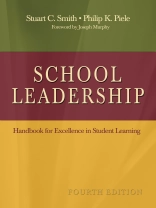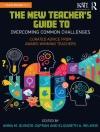‘Finely crafted and beautifully written . . . the most comprehensive and extensive treatment of the school leadership literature available to date.’
-From the Foreword by Joseph Murphy
A set of key leadership behaviors can help create the right kind of conditions in schools for learning to occur. How can school leaders excel in those behaviors?
An important and trusted resource for 25 years, this fourth edition of School Leadership: Handbook for Excellence in Student Learning emphasizes the school leader′s role as champion of student learning. Integrating theory and practice, the editors introduce school leadership from five perspectives: the person, the values, the structure, the mission, and the skills.
This expanded edition draws from a variety of viewpoints on educational leadership to give school leaders—and those preparing for the role—insight and wisdom to meet the challenges of helping all their students learn.
Updates include:
- Expanded coverage of instructional leadership and the principal′s role in student learning
- New chapters covering the principalship, accountability, effects of leadership, distributed leadership, political leadership, and engaging the public
- New chapters on data-based decision making and allocation of human, financial, and physical resources
- Eight completely reworked chapters that tie back to student learning
- End-of-chapter reflection questions for group discussion
This is the ultimate guide for all principals and administrators—both a life-preserver and indispensable coach for the important work of school leadership.
Table des matières
Foreword – Joseph Murphy
Preface
How This Book Was Written
Intended Audience
Method of Citation
Scope and Organization
Acknowledgments
About the Editors
About the Contributors
Introduction: Leadership for Excellence in Learning
The Mission Is Student Learning
What Is Leadership?
Assumptions About the Nature of Leadership
Conclusion: A Passion for Learning
PART I. The State of School Leadership
1. The Landscape of School Leadership – Larry Lashway
The State of the Principalship: A Snapshot
The Supply and Demand Challenge
What Is the Principal’s Proper Role?
Conclusion: What’s Over the Next Hill?
Reflections
2. The Effects of Leadership – Larry Lashway
The Search for Leadership Effects
Syntheses of the Evidence
Essential Acts of Leadership
Conclusion: A Compass, Not a Road Map
Reflections
PART II. The Person
3. Portrait of a Leader – Larry Lashway, Jo Ann Mazzarella, and Thomas Grundy
The Characteristics of Leaders
Personality
Competence
Mastery of Self
Interpersonal Competence
Character
Leadership Behaviors
The Genesis of Leadership
What We Don’t Know About Leadership
Implications
Conclusion: A Sketch for Each Leader to Complete
Reflections
4. Leadership Styles and Strategies – Larry Lashway
Dimensions of Leadership Style
Unanswered Questions About Style
The Importance of Style
Leadership Strategies
Hierarchical Leadership
Transformational Leadership
Facilitative Leadership
Is There a Best Strategy?
Choosing a Strategy
Conclusion: The Need for Clarity of Purpose
Reflections
5. Developing School Leaders – Larry Lashway
A Developmental Perspective
The Phases of Principals’ Careers
The Special Case of the Assistant Principal
Assessment Tools for Developing Leadership
Conclusion: A Pathway Uncertain Yet Sure
Reflections
PART III. The Values
6. Ethical Leadership – Larry Lashway
The Virtuous Leader
Making Ethical Decisions
Leaders as Advocates
Conclusion: A Question of Destiny
Reflections
7. Visionary Leadership – Larry Lashway
The Nature of Vision
The Impact of Vision
The Problem With Vision
The Leader’s Role
Developing Personal Vision
Tailoring the Vision to the School
Institutionalizing the Vision
Beyond Vision: The Learning Organization
Conclusion: Change as a Driving Force for Excellence
Reflections
8. Cultural Leadership – Stuart C. Smith
The Power of a Strong Culture
The Perspective of This Chapter
The Heart of the Matter
The Meaning of Culture
Three Levels of Culture
Principles for Shaping School Culture
How Leaders Construct Culture
Shaping the Student Subculture
Fostering a Sense of Community
Conclusion: Having the Heart to Persevere
Reflections
PART IV. The Structure
9. Accountable Leadership – Larry Lashway
The Many Faces of Accountability
The Leadership Challenge
Using Accountability to Improve Learning
Conclusion: A Core Leadership Responsibility
Reflections
10. Site-Based Management – Wendell Anderson
History and Structure of SBM
Participants
Site Councils
SBM and Academic Achievement
Role of the Principal in SBM
Role of the Superintendent and Other Administrators
Conclusion: Leaders’ Commitment Drives Change
Reflections
11. Distributed Leadership – Larry Lashway
Who Was That Masked Man, Anyway?
An Alternative Conception: Distributed Leadership
The Continuum of Leadership
Distributed Leadership in Schools
Varieties of Distributed Leadership
Making Distributed Leadership Work
Expanding Leadership Through Work Teams
Conclusion: Why the Effort Is Worthwhile
Reflections
12. Political Leadership – Larry Lashway
The Two Worlds of School Politics
Acting Politically
Conclusion: Being Political, Remaining Ethical
Reflections
PART V. The Mission: Student Learning
13. Instructional Leadership: Supporting the Learning Process – Ronald A. Beghetto and Julie Alonzo
What Is Learning?
Clarifying the Goals of Purposeful Learning
Selecting Instructional Strategies
Conclusion: Collaboration Is the Route to Success
Reflections
14. Instructional Leadership: Progress Monitoring – Ronald A. Beghetto and Leanne R. Ketterlin-Geller
What Is Progress Monitoring?
Using Multiple Sources of Information to Monitor Progress
Improving the Interpretation and Use of Information
Communicating Progress
An Example: Progress Monitoring in a School District
Conclusion: A Career-Long Practice
Reflections
15. Instructional Leadership: Cultivating a Learning-Focused Community in Schools – Ronald A. Beghetto
What Is a Learning-Focused Community?
Why Do Students Engage in or Avoid Achievement-Directed Behavior?
How Do Learning Communities Influence Students’ Achievement Behavior?
How Does the Learning Environment Influence Teachers?
Cultivating a Focus on Learning in the School Community
Conclusion: The Need for Creativity and Resolve
Reflections
PART VI. The Skills
16. Communicating – Wendell Anderson
Principles of Organizational Communication
Communication and Student Learning
The Communication Process
Communication Skills
The Silent Language
Administrative Writing
Conclusion: Perseverance Pays Off
Reflections
17. Engaging the Public – Wendell Anderson
A New Way of Doing Business
Connecting With the Community
Creating a Community-Relations Plan
Delivering the Message
Working With the News Media
Evaluating Community-Relations Efforts
Conclusion: Engaging for Mutual Benefit
Reflections
18. Managing Data for Decision Making: Creating Knowledge From Information – Gerald Tindal, Luke Duesbery, and Leanne R. Ketterlin-Geller
Principles of Data-Driven Decision Making
Developing an Infrastructure for Managing and Interpreting Data
Getting Accurate Data From All Students: Technical Adequacy and Universal Design
Reference for Interpreting Results: Using Graphic Displays to Evaluate Performance
Conclusion: The Goal Is Progress for All Students
Reflections
19. Allocating Human, Financial, and Physical Resources – Faith E. Crampton and Randall S. Vesely
Human Resources: Creating and Sustaining Human and Social Capital
Fiscal Resources: Making the Best Use of Existing Financial Resources
Physical Resources: Maintaining and Enhancing the Physical Environment of Schools
Conclusion: Comprehensive Planning Is Best Practice
Reflections
References
Index












